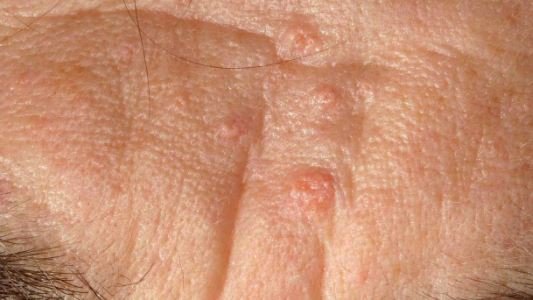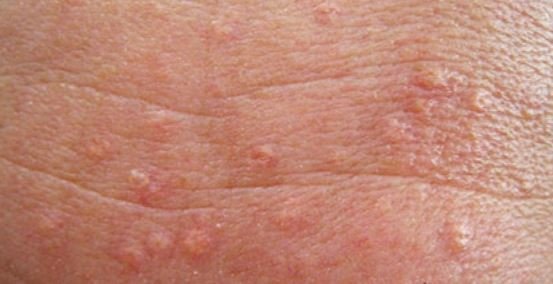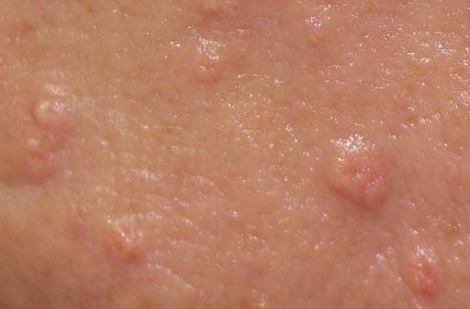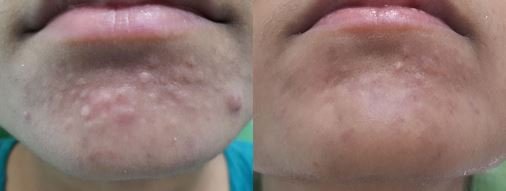Sebaceous Hyperplasia
What is Sebaceous Hyperplasia?
Sebaceous hyperplasia is non-cancerous condition that occurs in the oil glands (sebaceous glands). It is characterized by lesions that occur as small tender papules that are either single or on your body particularly on your forehead, cheeks and nose1, 3, 5.

Sebaceous hyperplasia occurs intermittently on your chest, shaft of the penis, vulva, scrotum, foreskin, mouth and areola. These lesions have no likelihood of becoming cancerous, but they are linked to nonmelanoma skin cancers that undergo an organ transplant.
This condition affects older adults and middle aged persons. Sebaceous hyperplasia also occurs in infants or newborns especially on their forehead, nose and upper lips. This is so because of the changes in the mothers’ hormones during pregnancy.
Sebaceous glands are found on the entire body except your sores and palm. The chest, face, back and top outer arm have many of these glands.
Causes
The real causes of sebaceous hyperplasia are not known. However, it is associated with changes in androgen hormones as a person ages.2
Symptoms
Sebaceous hyperplasia lesions appear as single or multiple on the skin. They are mostly observed in areas that have sebaceous glands such as forehead, nose, cheeks, chest, upper arms, mouth lips, etc. They are usually yellowish or pink painless bumps on the skin are indented in the center.4
You can go to a hospital if you notice the following:
- Lesions are interfering with the appearance of your skin and are also irritating.
- There are many lesions of your skin, usually more than 10 and they are bleeding.5
Diagnosis
Your doctor can investigate sebaceous hyperplasia using the following methods:
- Physical exam: In this exam, your doctor examines your skin for symptoms of sebaceous hyperplasia.
- Skin biopsy: Your doctor can conduct a skin biopsy to determine the cause of sebaceous hyperplasia. In this test, your doctor extracts a sample of your skin on the affected area and takes it to the laboratory for analysis to confirm this condition. A biopsy can help your doctor rule out the presence of other similar skin conditions.1
Treatment/ How To Get Rid
Sebaceous hyperplasia lesion can be eliminated by many treatment methods such as:
Electrocautery
This is a method that uses direct electric current through a metal to a diseases tissue in order to treat it. In this process, your doctor heats a metal using electric current and puts the metal directly on the lesion to treat it.
However, the use of electrocautery can be harmful to both the patient and the physician operating it and therefore it should be conducted with due care. This method can cause burns if there are inflammable materials near the treatment area. Substances such as alcohol and bowel gas are very inflammable. Alcohol cleansers should be allowed to dry or avoided completely. If the patient uses a moveable oxygen device, it should be briefly disconnected during the procedure.
It can also cause infections. Smoke, electrodes and aerosolized blood droplets can be propelled into the air where another person inhales them and becomes infected.
To prevent this risk of infection, your physician should ensure that there is a smoke evacuating system in treatment place, wear a protective facial mask, eye wear and gloves.
Cryosurgery
This is a form of surgery intervention that uses very cold temperatures to eliminate tumors and abnormal growths. Cryosurgery involves the use of liquid nitrogen or argon and carbon dioxide.
To conduct this procedure, your doctor will give you instructions to follow before the surgery depending on the type of surgery to be conducted. For skin lesions, there are little preparations you will do and your doctor will tell you. You are expected to inform your doctor if you are allergic to anesthesia and whether you have been using other medications.
During the procedure, your doctor injects a numbing medicine near the lesion to ease pain and make you comfortable during the procedure. Your doctor puts liquid nitrogen on the affected area on your skin using a piece of cotton or sprays it directly. The liquid nitrogen comes into contact with the lesion and the cells are frozen and die.
This procedure has risks such as it can cause blisters to form at the site of surgery. It can also damage close health tissues and blood vessels. It leaves scars at the place of surgery and can cause infection.
Excision
Your doctor can also remove the lesion through a procedure known as excision. In this procedure, your doctor uses a sharp instrument such as razor blade to cut and remove the lesion.
Laser
Laser therapies are treatments that use focused light to treat conditions. Laser helps doctors enhance precision of surgery since they are able to focus on a small area during operation. There are many laser therapies your doctor can choose from to eliminate the lesion.
In this procedure, your doctor focuses light on the affected lesion at a certain wavelength to destroy the lesion. Just like other surgery methods, laser therapy causes pain, bleeding and infections.
Photodynamic therapy
This is a type of treatment that uses drugs to make malignant cells and abnormal growths prone to powerful light from lasers.
In this procedure, your doctor applies a photosensitizer drug on the lesions that make them more sensitive to light. Once the tissues at the lesion absorb this drug, your doctor focuses light of certain wavelength to the lesion which activates the drug. The activated photosensitizer drug then eliminates the lesion.
Use of anti-androgen medications
Your doctor can recommend the use of drugs that have ant-androgen properties so as to limit your body from manufacturing testosterone and other hormones.
Retinol
Retinol contains vitamin A and it effective in treating sebaceous hyperplasia. It works by making the cells in your skin to act normally as they used to which leads to an improved looking skin.
Use of salicylic acid
Products that contain salicylic acid are effective in managing sebaceous hyperplasia. Apply it daily on your face
Use of isotretinoin
In case sebaceous hyperplasia is very severe, isotretinoin can be used to treat it. Isotretinoin is a type of medication that belongs to retinoids. This drug works by lowering the activity of oil glands and can treat sebaceous hyperplasia.4
Pictures






Reference List
- Sebaceous hyperplasia. https://www.skinsight.com/skin-conditions/adult/sebaceous-hyperplasia
- https://www.paulaschoice.co.uk/what-is-sebaceous-hyperplasia/art-50.html
- https://www.dermcoll.edu.au/atoz/sebaceous-hyperplasia/
- Sebaceous hyperplasia. https://www.dermnetnz.org/topics/sebaceous-hyperplasia/
- Sebaceous hyperplasia. http://www.the-dermatologist.com/content/treatment-extensive-sebaceous-hyperplasia
